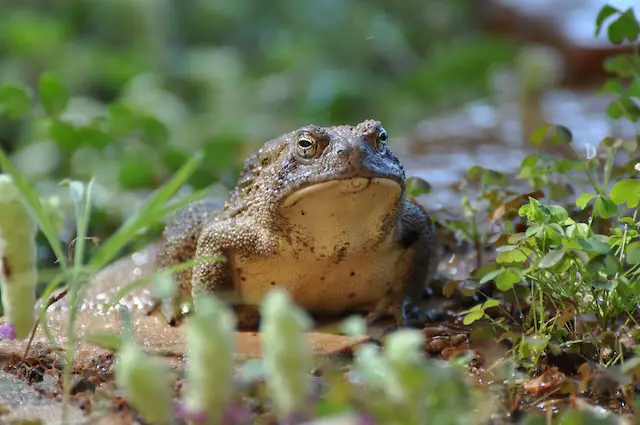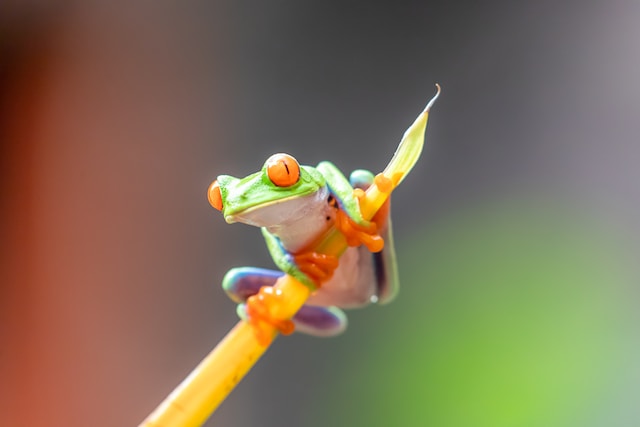While frogs and toads may look similar at first glance, they are actually quite different. Frogs have smooth, moist skin and tend to live near water sources, while toads have bumpy dry skin and can be found in a variety of habitats. Additionally, some species of toads can produce toxic secretions as a form of defense against predators.
What is a frog?
(Photo by gary tresize on Unsplash )

Frogs are cold-blooded amphibians that belong to the order Anura, which means “without a tail.” They are found all over the world and come in an incredible range of sizes and colors.
One thing that sets frogs apart from other animals is their remarkable ability to jump. Frogs have powerful legs that allow them to jump up to 20 times their body length in a single leap! This makes them one of the most agile creatures on land.
Another unique feature of frogs is their smooth, moist skin. Unlike many other animals, they don’t have scales or fur. Instead, they secrete mucus through their skin, which helps keep them hydrated and can also protect them from predators.
Frogs also have some unusual adaptations for survival. For example, some species can inflate themselves like balloons when threatened by predators as a way to deter attacks. Others can change color depending on their environment as a way to camouflage themselves.
In addition to being fascinating creatures in their own right, frogs play an important role in many ecosystems around the world as both predators and prey. By eating insects and other small creatures like snails and worms, they help keep populations under control while also serving as food for larger predators like birds and snakes.
What is a toad?
(Photo by Crystal McClernon on Unsplash )

Toads are amphibians that belong to the Bufonidae family. They have a stout body with dry and bumpy skin, which sets them apart from sleek-skinned frogs. Toads also have shorter hind legs, making them less agile than their frog counterparts.
One of the most notable characteristics of toads is their ability to secrete toxins as a form of defense mechanism against predators. These toxins can be harmful or even deadly to some animals but are not typically dangerous to humans unless ingested in large amounts.
Toads are also known for having a unique mating call, which sounds like a long trill or high-pitched whistle. During breeding season, male toads will congregate near water sources and call out in hopes of attracting females.
While they may not be as popular as frogs, toads play an important role in the ecosystem by controlling insect populations through their diet and serving as prey for larger animals such as birds and snakes.
While they may share similarities with frogs, there are distinct differences that make these amphibians unique in their own right.
Frogs Vs. Toads – Key differences
Frogs and toads may appear similar at first glance, but there are key differences between the two. One of the biggest differences is their skin texture. Frogs have smooth, moist skin while toads have dry, bumpy skin.
Another noticeable difference is in their legs. Frogs have long, powerful hind legs built for jumping and swimming while toads have shorter legs more suited for walking on land.
Their habitats also differ greatly; frogs prefer moist environments like ponds or streams while toads can be found in drier areas such as forests or deserts.
When it comes to breeding habits, frogs lay their eggs in clusters while toads deposit theirs in long chains. Additionally, tadpoles of frogs typically develop faster than those of toads.
In terms of behavior, frogs are often active during the day and will vocalize loudly whereas many species of toad are nocturnal and remain silent.
While both animals play important roles in ecosystems around the world, understanding these key differences between them can help with identification and conservation efforts.
Are toads poisonous to humans?
Toads are often associated with being poisonous or toxic to humans. However, not all toads are venomous and even those that have toxins use them as a defense mechanism rather than actively seeking out prey.
The poison glands in toads are located behind their eyes and can secrete a milky white substance when they feel threatened. This toxin is called bufotoxin and can cause irritation, swelling, and even death if ingested in large quantities.
It’s important to note that while the toxins of some species of toad can be harmful or deadly to humans if ingested, simply touching the skin of a toad will not cause harm.
In fact, it’s quite common for people who handle pet toads or participate in activities like catching frogs and tadpoles to come into contact with these amphibians without experiencing any negative effects.
If you do happen to come into contact with a poisonous species of frog or accidentally ingest their toxins, seek medical attention immediately.
Do toads have night vision?
Toads are nocturnal creatures, which means they are active at night. This adaptation is due to their eyes’ sensitivity to light. Toads have a layer of cells called the tapetum lucidum that reflects light back through the retina, allowing them to see in low-light conditions.
However, while it’s true that toads can see in the dark better than humans, they don’t have night vision per se. They rely more on other senses like hearing and sense of smell when navigating in complete darkness.
In fact, too much light can be harmful to their eyesight as well. Exposure to strong sunlight or bright lights for an extended period can cause damage to their retinas and reduce their ability to see effectively in dimly lit environments.
So next time you come across a group of hopping toads during your nighttime stroll, remember that they may not be able to see you clearly but rest assured that they possess some impressive adaptations for navigating in low-light conditions!
What are then types of frogs and toads
Frogs and toads come in a variety of shapes, sizes, and colors. There are over 7,000 species of frogs and toads in the world. Each type has unique features that make them different from others.
Some common types of frogs include treefrogs, which are known for their sticky toe pads that help them climb trees easily. Another example is the dart frog, which is famous for its bright colorful skin patterns and toxicity.
Toads also have various types such as cane toads which are among the largest species reaching up to 9 inches long. They have dry warty skin with large glands behind their eyes secreting toxins as defense against predators. Another kind is the American Toad recognizable by their brown color with white spots on its body.
Another interesting type of frog is the glass frog due to its translucent skin revealing internal organs including beating heart visible through chest area while it rests on leaves beside stream banks
There’s so much diversity within both frog and toad families with each having unique characteristics that set them apart from one another.
Featured Image By – Stephanie LeBlanc on Unsplash








